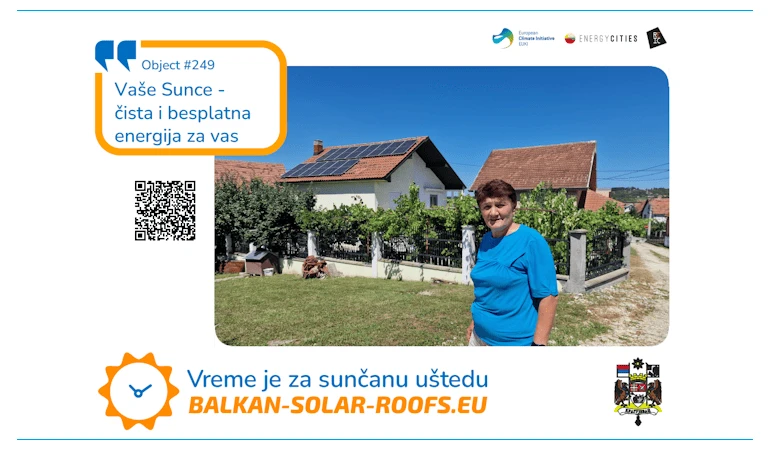Harnessing the sun: Western Balkans’ solar revolution and the success stories of three cities
In a region known for its rich cultural heritage and stunning landscapes, a quiet revolution is taking place – the Solar Revolution. This article by Melina Kalem was first published in Balkan Energy News
Cities in the Western Balkans are not just envisioning a future powered by the sun, they are actively shaping it, setting the stage for a sustainable tomorrow. Their mission: is to promote solar energy, empower local communities, and inspire the installation of new solar roofs.
At the heart of this solar renaissance is the “Balkan Solar Roofs” project, financed by the European Climate Initiative (EUKI), and implemented in the region by Energy Cities and the Regional Center for Education and Information on Sustainable Development for Southeast Europe (REIC) in Sarajevo. Energy Cities is an EU city network that provides and develops tools to increase locally-owned renewable energy production. REIC, a focal point for capacity-building processes for environmental education and sustainable development in Southeast Europe, has taken up a vital role in coordinating cities’ solarization and capacity development efforts.
Two years ago, three pilot cities and their municipal administrations – Kragujevac in Serbia, Mostar in Bosnia and Herzegovina, and Poreč-Parenzo in Croatia – embarked on a city solarization journey with the aim of both promoting and encouraging the use of solar energy and building capacity within local government to share knowledge about solar and energy communities whilst boosting citizen participation. The goal of the project is to have at least 500 new solar roofs installed by 2024.
Poreč-Parenzo: A solar pioneer
Poreč-Parenzo, one of the project’s pioneering cities, showcases the power of early adoption. In 2014, the city installed photovoltaic power plants and solar collector systems on eight public buildings, generating over 1,000,000 kWh of green electricity. The city is also a leader in sustainable energy projects, such as the Poreč e-City bus and energy-efficient public lighting.
“After several conversations with citizens on the topic, it became clear that many people did not know where to start when installing their solar system. The Poreč Sunny Office was created to meet this need: giving advice and technical support to our citizens,” says Loris Peršurić, mayor of Poreč-Parenzo.
Mostar’s journey to “Good Energy”
Mostar, a city in Bosnia and Herzegovina is actively shaping a path to becoming a “city of good energy.” The city signed the Declaration on Good Energy in 2023, which aims to ensure equal access to renewable energy sources for all citizens. With a pilot project subsidizing a prosumer facility, the focus is on rooftop solar power plants. Mostar focuses on supporting its citizens to install solar power plants through consultation, education, financial aid, and streamlined procedures.
“The potential for leading the energy transition lies in the widespread installation of solar power plants on the roofs of our buildings. However, this won’t occur spontaneously. Providing extensive support to both city and citizens is imperative,” emphasizes Darko Knezović, Energy Manager and Coordinator of the City of Mostar.
Kragujevac’s ambitious climate goals
Kragujevac is boldly addressing climate change by setting ambitious targets of reducing greenhouse gas emissions by 40% by 2030 and achieving carbon neutrality by 2050. To reach these goals, Kragujevac is implementing a range of measures, from energy efficiency enhancement in construction to promoting sustainable transportation.
Three solar power plants have already been installed on Kragujevac’s public buildings, including a kindergarten and a public parking lot. Over 20 households have installed solar panels on their roofs, thanks to subsidies given by the city and the Ministry of Mining and Energy.
“After the initial investment, solar power is free, easily available, and accessible to all. Using solar power can significantly reduce electricity bills,” says Ana Radojević, energy manager of the City of Kragujevac.
Kragujevac was also the proud host of the Balkan Solar Roofs final event in September 2023, which brought together representatives from the three pilot cities, follower cities, project partners, and enthusiastic citizens eager to join the solar revolution. The primary goal was to enhance the capacity of all involved parties, share successful strategies, and discuss the challenges faced when implementing initiatives within the project.
Follower cities
Many cities have decided to join in on this solar journey. The city of Pirot, a pioneer in renewables and community energy, was the first to join the campaign after the three pilots. It has joined forces with one of Serbia’s energy cooperatives, Elektropionir, signing a memorandum of cooperation to set up Serbia’s first two cooperative solar power plants.
A bright solar future for the Western Balkans?
The collaborative efforts in the Western Balkans demonstrate the growing potential of the adoption of solar energy; but as they stride towards a greener future, they must confront a variety of challenges, including phasing out fossil fuels and bridging the gap in green skills; Legal and administrative mechanisms must be made accessible to citizens, leaving the journey to sustainability at an uncertain crossroads.
However, even at the crossroads of challenges, each city’s unique journey proves that the potential for a radiant solar and renewable future is well underway.
By Melina Karem, first published in Balkan Energy News





